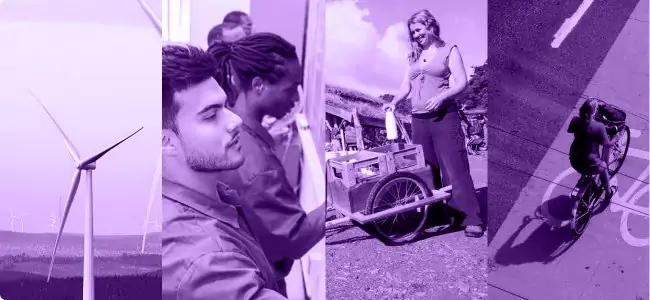The Spark: The Unforeseen Benefits That Blossom When You Reuse And Repair
Welcome back to The Spark, our monthly newsletter that’s all about how people just like you are creating positive change, one meaningful step at a time. The Spark is generously supported by Laura Rice.

Anyone can dig into community composting

A school where kids learn to fix what’s broken

Don’t demolish that house –– deconstruct it!
Composting is more effective –– and more fun –– as a community
In 2009, Tim Bennett wanted to start composting his food waste — an inconvenient dream for a 27-year-old apartment dweller in one of the densest parts of Philadelphia. The city doesn’t collect organic waste for composting, so he decided to take matters into his own hands.
“When you throw things away, they just disappear like magic. But they don’t really disappear — they go to a landfill,” says Bennett. In the U.S., food is the most common material sent to landfills, making up almost a quarter of municipal solid waste. It’s responsible for 58 percent of landfill methane emissions, which have 80 times more global warming potential than carbon dioxide on a 20-year timescale.
Composting not only neutralizes these impacts, it reverses them. During composting, microorganisms transform organic waste into a slow-release fertilizer that increases soil’s resilience to extreme weather events and helps it store more carbon.
Bennett’s idea was simple: For a small fee, he would collect his neighbors’ food scraps and turn them into compost. He connected with someone starting an urban garden and set up a composting system in a corner of the plot, paying “rent” for the space in compost. With $100 of start-up capital, he bought a couple of five-gallon buckets for scrap collecting, rented a pickup truck for two hours per week at a cheap night-time rate, and printed a stack of flyers to hang in local coffee shops. “I thought it probably wouldn’t work, but I’d learn a lot,” he recalls.

But orders started trickling in, and today Bennett Compost picks up food scraps from 6,500 households in Philadelphia, diverting over 150 tons of food waste from landfills each month. Bennett’s clients are no longer just residents — his enterprise works with local businesses, public schools, rec centers and the Philadelphia Department of Prisons.
His business is part of the Community Composter Coalition, organized by the U.S.-based nonprofit Institute for Local Self-Reliance. The coalition brings together over 400 community composting initiatives, everything from schools, urban farms and small-scale neighborhood efforts to well-oiled citywide enterprises.
There are many ways people can get involved in composting on an individual level, from setting up a worm bin in their apartment or a compost tumbler in the back yard, to lobbying public officials to start a compost program, says Bennett.
Weighed down by negative news?
Our smart, bright, weekly newsletter is the uplift you’ve been looking for.Composting as part of a community does more than simply turn waste into a resource. It supports local food resilience, creates green jobs, provides opportunity for education and brings people together around a tangible shared goal. “You can’t do composting online,” laughs Bennett. “A lot of good things can come out of those conversations when you’re standing next to somebody, just turning the compost pile.”
To get started, Bennett suggests connecting with other community initiatives that might have some outdoor space to spare, like urban gardens. He also credits partnering with other like-minded local projects for the long-term success of this business. “We had to do it because we didn’t have the money to do it on our own,” he says. “But it made us better at what we do, and it made us do it in a way that was respectful of the neighborhoods we were operating in.”
Click here to find a composting initiative near you. Want to start one of your own? Get started with resources available through the ILSR and the EPA.
Repair cafés turn schools into workshops
Every Thursday afternoon, the Rudolf Steiner School Schwabing in the German city of München opens its doors to the public, accepting broken electronics and wooden items to be repaired by the students, free of charge. Coffee machines, medical devices, car keys, battery-operated toys — the young repair whizzes here have seen and repaired it all.
Launched in 2016 by the school’s math and physics teacher Walter Kraus, the Schüler Reparaturwerkstatt (Student Repair Shop) teaches students the value of everyday objects while imparting crucial life skills. While volunteer repair experts are on hand to support their work, the 12- to 18-year-old students manage the entire process, speaking with clients, organizing their teams’ work, identifying problems and finding solutions, and ordering or 3D-printing spare parts.


Wait, you're not a member yet?
Join the Reasons to be Cheerful community by supporting our nonprofit publication and giving what you can.
Join Cancel anytimeFor educators looking to launch a repair café in their own school, the Repair Shop offers a detailed handbook available in multiple languages, while Repair Café International offers teaching plans for primary school educators who want to teach basic repair skills in their classrooms.
One good house deserves another
One of the world’s most resource-hungry industries — construction — is slowly embracing reuse as demolition gives way to careful “deconstruction,” which enables a building’s old materials to be reused in future projects.
The growing number of stores that resell second-hand construction materials offers home owners and DIY enthusiasts a chance to buy everything from used lumber, bricks and flooring, to antique hardware, light fixtures and furniture.
Salvaged building materials can be bought and donated at over 1,000 of Habitat for Humanity’s ReStores across North America, or local institutions like the Architectural Salvage Warehouse of Detroit, the ReBuilding Center in Portland and the Rebuilding Exchange in Chicago.






Please be good and do not spam. Thank you.